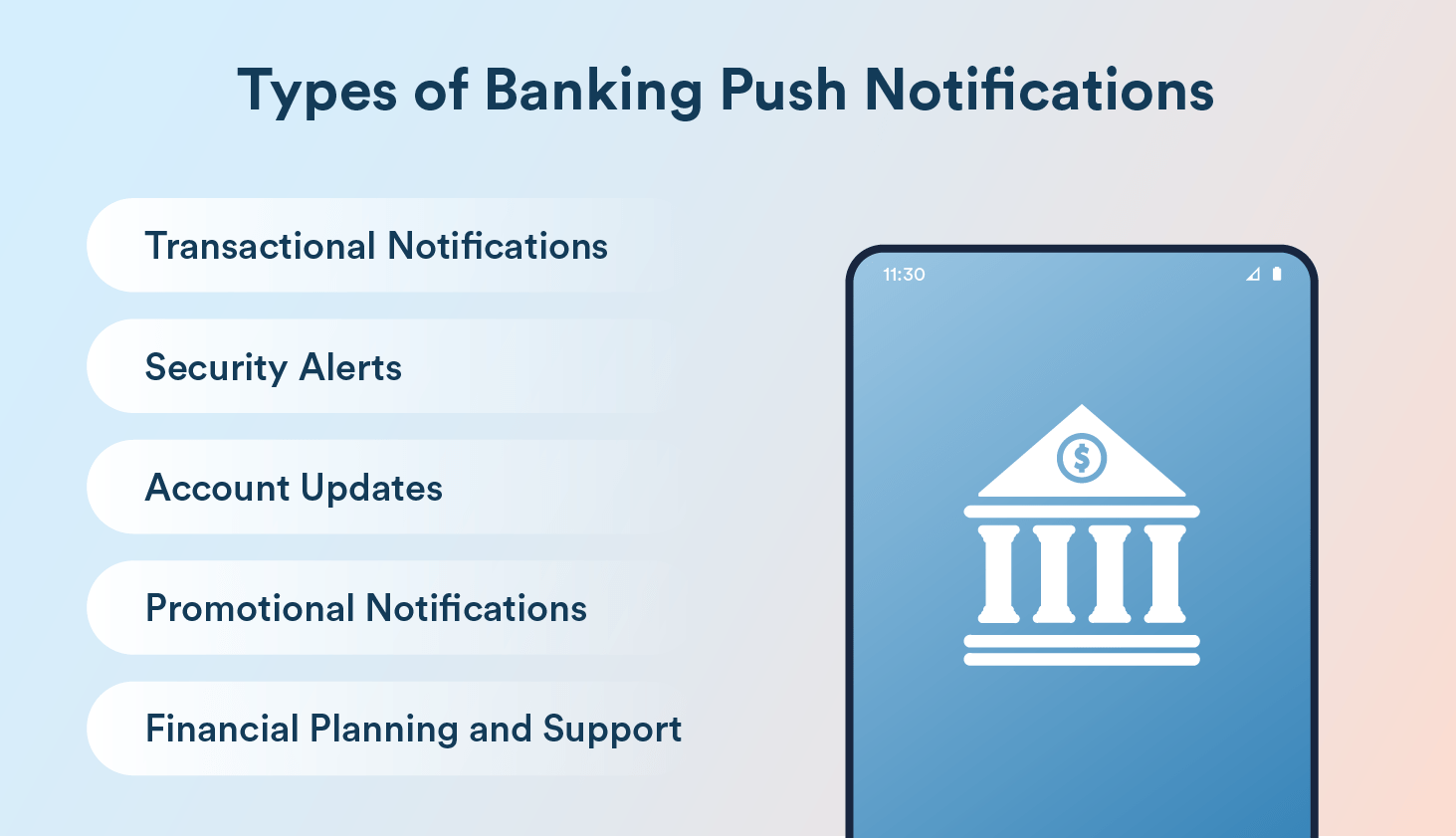Banking push notifications help banks notify their customers with real-time alerts, security updates, and personalized communications. This blog discusses the concept of push notifications in banking, their types, use cases, and examples.
Push notifications have become a cornerstone of communication in the banking sector, enhancing customer engagement and providing sensitive information on time.
As financial institutions strive to meet their customers where they are, understanding what banking push notifications are and how they can be effectively utilized is crucial.
What is Push Notification in Banking?
Banking push notifications are instant, real-time messages sent directly to a user’s mobile device through their banking application, even when the app isn’t actively in use. These notifications serve as a crucial communication channel between financial institutions and their customers, delivering time-sensitive information and important updates about their accounts and services.
Unlike traditional communication methods such as emails or SMS, banking push notifications offer immediate visibility and higher engagement rates by appearing directly on the user’s device screen. They play a vital role in keeping customers informed about their financial activities, security concerns, and account updates in real time.
Key Features of Push Notifications in Banking
Push notifications help banks maintain transparent communication with their customers while enhancing security, improving user experience, and fostering trust through timely updates about account activities, potential fraud alerts, and relevant banking services. Key characteristics of bank notifications include:
- Real-Time Communication: Instant alerts about transactions or account changes keep users informed.
- Actionable Messages: Notifications often include direct links or buttons for immediate actions (e.g., “View Transaction” or “Pay Now”).
- Security Features: Encrypted communication channels protect sensitive financial information.
- Rich Media Support: Ability to include images or longer message formats when needed.
- Personalization: Tailored messages based on user behavior enhance relevance and engagement.
Types of Banking Push Notifications
Push notifications in banking come in several distinct types, each serving a specific purpose in enhancing the customer banking experience.

Transactional Notifications
Transactional notifications form the foundation of banking communications. They keep users informed about specific account activities, such as successful transaction confirmations and balance updates, when they reach certain thresholds. These regular updates help build trust and maintain user engagement with their financial activities.
Security Alerts
Security alerts represent another critical category of push notifications in banking. These communications protect user accounts by providing immediate notifications about suspicious activities and potential fraud attempts. By promptly alerting customers to potential security threats, banks strengthen customer confidence in their ability to protect financial assets.
For instance, if suspicious activity is detected on a customer’s card, they might receive an immediate alert stating, “We detected suspicious activity on your card at [location]. Call us immediately if this isn’t you.”
Account Updates
Account updates focus on keeping customers informed about significant changes to their banking relationships. For instance, when an account upgrade occurs, users may receive alerts such as, “Your account has been upgraded! Enjoy new features like higher withdrawal limits and lower fees.”
These include confirmations of new account openings and updates on loan application statuses, helping maintain customer awareness and engagement with their banking services.
Promotional Notifications
Banks also leverage push notifications for marketing purposes through promotional communications. These include alerts about new financial products and services, as well as notifications about limited-time offers and discounts.
For example, they may alert users about promotional offers like credit card deals or loan interest rates. A notification could read, “Big purchase coming up? Get 6 months interest-free when you pay overtime.”
When executed effectively, these promotional banking push notifications can drive customer interest and increase product adoption.
Financial Planning and Support
Financial planning and support notifications serve as a valuable educational tool. By sending budgeting tips and investment advice through push notifications, banks position themselves as supportive partners in their customers’ financial journey. These communications help foster stronger relationships by providing valuable financial guidance and resources directly to customers’ devices.
Learn How Axis Bank Improved Engagement with CleverTap’s Platform.
Use Cases and Examples of Banking Push Notifications
Real-time Alerts
Real-time alerts are crucial for keeping customers informed about their finances. For instance, a user might receive a notification when a payment is processed, alerting them that a recent transaction was successful. This immediate feedback helps users stay on top of their financial activities and promotes responsible spending habits.
For example, a bank may send a notification stating, “Your payment of $150 to XYZ Utility has been processed successfully.” This type of alert reassures the customer that their transaction went through without issues.
Users can also receive notifications if their account balance falls below a specified amount, such as, “Your balance is now below $100. Consider transferring funds to avoid overdraft fees.” This proactive approach helps customers manage their finances more effectively and prevents unexpected charges.

Customer Engagement
Banks use push notifications to enhance customer engagement by keeping users informed about new features or services. For example, a bank might notify users about an upcoming app update that includes new budgeting tools, encouraging them to explore these features actively.
For example, a notification could read, “Exciting news! Our app has been updated with new budgeting tools to help you manage your expenses better. Check it out now!” This not only informs users but also encourages them to engage with the app’s new functionalities.

Banks can also use push notifications to request feedback on recent transactions or services, such as, “How was your experience using our mobile deposit feature? Let us know!” This fosters community and shows that the bank values customer opinions.
Get inspired by these customer engagement examples from top brands.
Onboarding Processes
Push notifications play a significant role in onboarding new users. After registering for an online banking account, users might receive notifications guiding them through app features, such as setting up direct deposits or linking external accounts.
For example, upon account creation, the user could receive messages like, “Welcome to [Bank Name]! Your account is now active. Set up direct deposit today for faster access to your funds.” This step-by-step guidance helps users acclimate to the banking app quickly.

Notifications can also highlight key features that enhance user experience, such as, “Did you know you can easily transfer money between accounts? Try it out today!” This encourages exploration and utilization of the app’s functionalities.
Personalized Financial Advice
Banks can use data analytics to send tailored push notifications based on user behavior. For example, if a user frequently checks their savings balance, the bank might send tips on saving strategies or alerts about high-interest savings accounts that could benefit them.
Example: A notification might say, “Hi [User’s Name], we noticed you often check your savings account. Consider our high-interest savings account for better returns!” This personalized approach makes users feel valued and understood.

Additionally, banks can provide insights into spending habits with messages like, “You’ve spent 20% more on dining this month compared to last month. Would you like tips on budgeting?” Such insights empower users to make informed financial decisions.
Learn how to adhere to push notification character limits.
Upgrade Banking Push Notifications with CleverTap
CleverTap enables banks to go beyond basic message delivery, empowering them to send highly personalized, timely, and effective push notifications that truly engage users.
As an all-in-one customer engagement and retention platform, CleverTap helps brands turn user insights into targeted messaging strategies. From customer segmentation and automation to rich media and AI-driven content, it ensures every push notification is timely, relevant, and impactful.
Why Banks Choose CleverTap
CleverTap’s all-in-one engagement platform offers:
Real-Time Behavioral Segmentation: Target users based on actions, preferences, and lifecycle stage for greater relevance.
Automated Transactional Messaging: Trigger push notifications for updates, reminders, or alerts without manual effort.
Multi-Channel Orchestration: Ensure consistent communication across push, in-app, email, SMS, and more.
Security Compliance: All notifications and customer interactions are handled through secure, encrypted channels.
Advanced Features That Drive Engagement
Rich Media Support: Add images, videos, emojis, and GIFs to make notifications more engaging and memorable.
A/B Testing with IntelliNODE: Experiment with up to 35 journey variations to discover what works best for each segment.
AI-Powered Personalization
Clever.AI predicts user behavior and tailors content that resonates emotionally.Scribe helps craft push messages optimized for emotional tone—leveraging triggers like Joy, FOMO, and Trust.
Solving the Android Visibility Problem
A common issue in mobile banking: 40% of push notifications on Android devices may never appear due to battery optimization or inactive apps. CleverTap’s RenderMax™ solves this by:
- Bypassing strict device-level restrictions
- Re-attempting delivery when devices wake from battery-saving modes
This technology ensures that more of your messages are not just sent, but actually seen.
See how CleverTap can transform your banking push notification strategy.
Home Credit Indonesia Achieved 3.5x Industry CTR with CleverTap’s Targeted Push Notifications
Home Credit Indonesia faced challenges with backend limitations affecting push notification delivery and lacked a comprehensive view of user behavior.
CleverTap provided a solution by integrating real-time analytics and multi-channel messaging, enabling segmentation, targeted push notifications, and in-app messages. A/B testing optimized campaign effectiveness, while enhanced push delivery improved reach on devices like Xiaomi. The platform’s dashboards helped monitor user behavior, thus improving lifecycle engagement. These features led to a click-through rate of 3.5 times the industry average.
For more details, see the full case study here.
Push notifications provide an instant way for banks to communicate with their customers in this increasingly connected world. Incorporating various types of push notifications can help banks foster stronger relationships with their clients while ensuring they remain informed and secure in their financial dealings.

See how today’s top brands use CleverTap to drive long-term growth and retention
Agnishwar Banerjee 
Leads content and digital marketing.Expert in SaaS sales, marketing and GTM strategies.
Free Customer Engagement Guides
Join our newsletter for actionable tips and proven strategies to grow your business and engage your customers.















































